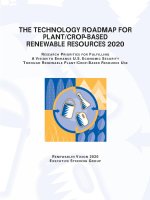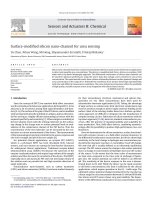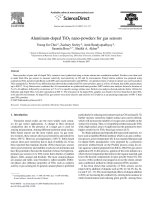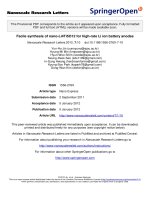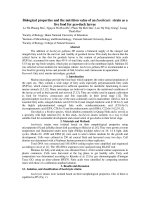Nano fertilizers for balanced crop nutrition
Bạn đang xem bản rút gọn của tài liệu. Xem và tải ngay bản đầy đủ của tài liệu tại đây (139.41 KB, 12 trang )
Chapter 3
Nano-fertilizers for Balanced Crop Nutrition
Kizhaeral S. Subramanian, Angamuthu Manikandan,
Muthiah Thirunavukkarasu, and Christopher Sharmila Rahale
Abstract Fertilizers play a pivotal role in improving the productivity across the
spectrum of crops. The nutrient use efficiencies of conventional fertilizers hardly
exceed 30–35 %, 18–20 %, and 35–40 % for N, P, and K which remained constant
for the past several decades. Nano-fertilizers intended to improve the nutrient use
efficiencies by exploiting unique properties of nanoparticles. The nano-fertilizers
are synthesized by fortifying nutrients singly or in combinations onto the adsorbents
with nano-dimension. Both physical (top-down) and chemical (bottom-up)
approaches are used to produce nanomaterials, and the targeted nutrients are loaded
as it is for cationic nutrients (NH4+, K+, Ca2+, Mg2+) and after surface modification
for anionic nutrients (NO3À, PO42À, SO42À). Nano-fertilizers are known to release
nutrients slowly and steadily for more than 30 days which may assist in improving
the nutrient use efficiency without any associated ill-effects. Since the nano-fertilizers are designed to deliver slowly over a long period of time, the loss of nutrients
is substantially reduced vis-a-vis environmental safety. The work done on nanofertilizers is very limited across the globe, but the reported literature clearly
demonstrated that these customized fertilizers have a potential role to play in
sustaining farm productivity. This chapter focuses on synthesis and characteristics
of macro- and micronutrient carrying nano-fertilizers and their application in
achieving balanced crop nutrition.
3.1
Introduction
Fertilizers are inevitable factor in improving soil fertility and productivity of crops
regardless of the nature of cropping sequence or environmental conditions. It has
been unequivocally demonstrated that one third of crop productivity is dictated by
fertilizers besides influencing use efficiencies of other agri-inputs. In the past four
decades, nutrient use efficiency (NUE) of crops remained constant despite our
K.S. Subramanian (*) • A. Manikandan • M. Thirunavukkarasu • C.S. Rahale
Department of Nano Science & Technology, Directorate of Natural Resource Management,
Tamil Nadu Agricultural University, Coimbatore 641003, India
e-mail:
© Springer International Publishing Switzerland 2015
M. Rai et al. (eds.), Nanotechnologies in Food and Agriculture,
DOI 10.1007/978-3-319-14024-7_3
69
70
K.S. Subramanian et al.
relentless efforts. The nutrients that are left in the soil may enter into the aquatic
environment causing eutrophication. In addition to the low nutrient efficiencies,
agriculture in developing countries including India is facing a problem of low
organic matter, imbalanced fertilization, and low fertilizer response that eventually
caused crop yield stagnation (Biswas and Sharma 2008). The fertilizer response
ratio in the irrigated areas of the country has decreased drastically. It has been
reported that 27 kg NPK haÀ1 was required to produce one ton of grain in 1970,
while the same level of production can be achieved by 109 kg NPK haÀ1 in 2008.
The optimal NPK fertilizer ratio of 4:2:1 is ideal for crop productivity, while the
current ratio is being maintained at 6.7:3.1:1 in India due to the excessive use of
nitrogenous fertilizers. In order to achieve a target of 300 million tons of food grains
and to feed the burgeoning population of 1.4 billion in the year 2025, the country
will require 45 Mt of nutrients as against a current consumption level of 23 Mt. The
extent of multi-nutrient deficiencies is alarmingly increasing year by year which is
closely associated with a crop loss of nearly 25–30 %. The extent of nutrient
deficiencies in the country is of the order of 90, 80, 50, 41, 49, and 33 % for N,
P, K, S, Zn, and B, respectively. Thus, from all sources, the country will be required
to arrange for the supply of about 40–45 Mt of nutrients by 2025 (Subramanian and
Tarafdar 2009).
Nanotechnology deals with particles measuring a dimension of one-billionth of a
meter or one-millionth of a millimeter. This enables atom-by-atom manipulation,
and thus processes or products evolved from nanotechnology are very precise and
hardly possible to achieve through conventional methods. This fascinating field of
science has been exploited widely in engineering, health, electronics, and material
sciences, and agricultural scientists have begun to use it as a tool to improve the
input use efficiencies by integrating nanotechnological approaches in the conventional production system. In this context, there would be greater importance of the
information about how to increase the NUE of fertilizers by nanotechnology in the
coming years.
In this chapter, current status of understanding of nano-fertilizer formulations
and its associated effects on crop production systems has been narrated.
3.1.1
Nano-fertilizers
Nano-fertilizers are nutrient carriers of nano-dimensions ranging from 30 to 40 nm
(10À9 m or one-billionth of a meter) and capable of holding bountiful of nutrient
ions due to their high surface area and release it slowly and steadily that commensurate with crop demand. Subramanian et al. (2008) reported that nano-fertilizers
and nanocomposites can be used to control the release of nutrients from the
fertilizer granules so as to improve the NUE while preventing the nutrient ions
from either getting fixed or lost in the environment. Nano-fertilizers have high use
efficiency and can be delivered in a timely manner to a rhizospheric target. There
are slow-release and super sorbent nitrogenous and phosphatic fertilizers. Some
3 Nano-fertilizers for Balanced Crop Nutrition
71
new-generation fertilizers have applications to crop production on long-duration
human missions to space exploration (Lal 2008). Recently, Subramanian and
Sharmila Rahale (2013) have monitored the nutrient release pattern of nanofertilizer formulations carrying fertilizer nitrogen. The data have shown that the
nano-clay-based fertilizer formulations (zeolite and montmorillonite with a dimension of 30–40 nm) are capable of releasing the nutrients particularly N for a longer
period of time (>1,000 h) than conventional fertilizers (<500 h). Subramanian and
Tarafdar (2009) suggested that clay particles are adsorptive sites carrying reservoir
of nutrient ions. Major portion of nutrient fixation occurs in the broken edges of the
clay particles. Zero valence nanoparticles adsorb onto the clay lattice, thereby
preventing fixation of nutrient ions. Further, nanoparticles prevent the freely mobile
nutrient ions to get precipitated. These two processes assist in promoting the labile
pool of nutrients that can be readily utilized by plants. Fertilizer particles can be
coated with nano-membranes that facilitate in slow and steady release of nutrients.
This process helps to reduce loss of nutrients while improving fertilizer use
efficiency of crops.
3.2
Synthesis of Nano-fertilizers
Nano-fertilizers are synthesized by top-down (physical) or bottom-up (chemical)
approaches. Top-down approach is a commonly used method. In top-down
approach, the adsorbent or substrate used for synthesis of nano-fertilizers such as
zeolite or any other carrier is ball milled for several hours to achieve nanodimension. Usually, natural zeolite measures a range of 1,000–3,000 nm, and
grinding using high-energy ball mill reduced the size of the particles. Manikandan
and Subramanian (2014) reported that the ball milling of zeolite at 1, 2, 4, and 6 h
had reduced the dimension 1,078, 475, 398, 357, and 203, respectively. The size
reduction closely coincided with the increase in the surface area of 41, 55, 72, 83,
and 110 m2 gÀ1. Such phenomenal increase in the surface area provides extensive
surface area for nutrient adsorption and desorption. Despite the physical method of
nanoparticle synthesis is very simple, the product is heterogeneous and particles
often get agglomerated. To prevent agglomeration, stabilizing agents such as polymers or surfactants are used.
The studies on slow-release fertilizers (SRFs) based on zeolites are limited to
nutrients, which can be loaded in cationic forms such as NH4+ and K+. However, if
the nutrients are in anionic forms such as SO42À, NO3À, and PO43À, the loading is
negligible on unmodified zeolites. Therefore, it is imperative that the material
should have adequate affinity for anions so that the anionic nutrients can be
efficiently loaded for its use as SRFs. Anionic properties can easily be imparted
on the zeolitic surface using the concept of surface modification using surfactant.
Surface modification facilitates the loading of anion into the zeolite’s surface by the
anion exchange process. Haggerty and Bowman (1994) reported that surfactantmodified zeolite (SMZ), a type of inexpensive anion exchanger has been shown to
72
K.S. Subramanian et al.
remove anionic contaminants from water. Hexadecyltrimethylammonium bromide
(HDTMABr), a cationic surfactant, was used for surface modification of zeolite,
and results showed that at HDTMABr loading maximum of 200 mmol kgÀ1,
corresponding to 200 % of the zeolite’s effective cation exchange capacity, a
surfactant bilayer would form and the surface was reversed to positive (Li and
Bowman 1997).
Li et al. (1998) revealed that SMZ has been studied extensively in the last
15 years due to its high capacity of sorption and retention of oxyanions. The
surfactant molecules (HDTMABr) form bilayers on zeolite external surfaces with
the lower layer held by electrostatic interaction between the negatively charged
zeolite surface and the positively charged surfactant head groups, while the upper
layer is bound to the lower layer by hydrophobic forces between the surfactant tail
groups in both layers (Bowman 2003). Surface modified zeolite showed that
positive results have been reported on the retention of chromate (Krishna
et al. 2001) and phosphate (Bansiwal et al. 2006). Li and Zhang (2010) reported
that the loading capacity of sulfate compared to nitrate on SMZ may be attributed to
the charge effect of the anions. Each HDTMABr molecule contributes one positive
charge, which needs only one negative charge to balance. Sulfate is divalent and
thus needs two HDTMABr molecules to neutralize. Meanwhile, the HDTMABr
surface configuration is not rigid because of the surfactant tail–tail interaction.
Thus, bridging two HDTMABr molecules with one sulfate may be less favored
compared to 1:1 neutralization of HDTMABr by nitrate.
3.3
Characterization of Nano-fertilizers
Synthesized nano-fertilizers are to be characterized using particle size analyzer
(PSA), zeta analyzer, Fourier transform infrared spectroscopy (FTI-IR), Raman
spectroscopy, X-ray diffraction (XRD), scanning electron microscope (SEM),
energy dispersive X-ray spectroscopy (EDAX), transmission electron microscope
(TEM), and atomic force microscope (AFM) to confirm the size, shape, charge
distribution, functional groups, elemental composition, surfactant attachment, and
sulfate attachment. The synthesized nano-fertilizers have been characterized using
the set of equipments listed above. Extensive studies had been undertaken to
characterize nitrogenous (Subramanian and Sharmila Rahale 2013; Mohanraj
2013; Manikandan and Subramanian 2014), phosphatic (Bansiwal et al. 2006;
Adhikari 2011; Behnassi et al. 2011), potassic (Subramanian and Sharmila Rahale
2012), sulfatic (Selva Preetha et al. 2014; Thirunavukkarasu 2014), and zinc
(Subramanian and Sharmila Rahale 2012) fertilizers.
3 Nano-fertilizers for Balanced Crop Nutrition
3.4
73
Nano-fertilizer Research
Nano-fertilizer is quite innovative, and recent publications strongly supported that
there is a lot to be done before the technology reaches the farm gate. Almost all
essential nutrients have been attempted to be delivered through nano-adsorbents. In
most cases, clays and other aluminum silicates have been used as effective adsorbents to deliver nutrients. It has been unequivocally demonstrated that the size
reduction by physical or chemical methods increased the surface mass ratio;
thereby, bountiful of nutrient ions get adsorbed and desorbed slowly and steadily
for an extended period of time (Table 3.1). This table summarizes the literature
review on nano-fertilizer formulations published in the recent past. Despite these
literatures are in support of nano-fertilizer technology, still the data are yet to
establish whether nutrient release is adjusted or regulated in accordance with the
crop demand.
3.5
Mode of Entry
Plant cell wall acts as a barrier for easy entry of any external agents including
nanoparticles into the plant cells. The sieving properties are determined by pore
diameter of cell wall ranging from 5 to 20 nm (Fleischer et al. 1999). Hence, only
nanoparticles with diameter less than the pore diameter of the cell wall could easily
pass through and reach the plasma membrane. There is also a chance for enlargement of pores or induction of new cell wall pores upon interaction with engineered
nanoparticles which in turn enhance nanoparticle uptake. Further internalization
occurs during endocytosis with the help of a cavity-like structure that forms around
the nanoparticles by plasma membrane. They may also cross the membrane using
embedded transport carrier proteins or through ion channels. In the cytoplasm, the
nanoparticles are applied on leaf surfaces; they enter through the stomatal openings
or through the base of the trichomes and then translocated to various tissues.
However, accumulation of nanoparticles on photosynthetic surface causes foliar
heating which results in alterations of gas exchange due to stomatal obstructions
that produce changes in various physiological and cellular functions of plants
(Fernandez and Eichert 2009).
3.5.1
Nanocapsules Enter Plants Through Stomata Orifices
and Prevent Infection
The crop protection agents (CPAs) are nano-encapsulated, and the resulted polymer
nanocapsules are sprayed onto the leaf tissue. These nanocapsules enter the plant
through the stomata orifices. The nanocapsule’s chemical bonds of the polymer
74
K.S. Subramanian et al.
Table 3.1 Synthesis, characteristics, and nutrient release from nano-fertilizers/formulations
Nutrients
Adsorbent
Approach
Size
N
Zeolite
Physical
Montmorillonite
Physical
Zeolite
Surface crosslinked superabsorbents (hydrogels)
Zeolite
Hydroxyapatite
nanoparticles
+ Gliricidia
sepium
Zeolite
Chemical
Chemical
25–
30 nm
35–
40 nm
200 nm
40–
80 nm
Physical
Biological
Nutrient
release (h)
References
400
Subramanian and
Sharmila Rahale
(2013)
–
672
Komarneni (2010)
Liu et al. (2006)
420 μm
19–
25 nm
16
1,440
Li (2003)
Kottegoda
et al. (2011)
Physical
60 nm
1,176
Zeolite
Chemical
480
Zeolite
Physical
7–
10 nm
87 nm
Selva Preetha
(2011)
Mohanraj (2013)
1,152
Montmorillonite
Chemical
50 μm
240
Zeolite
Physical
1,104
Montmorillonite,
bentonite
Zeolite
Physical
Physical
25–
30 nm
35–
40 nm
60 nm
1,000
Zeolite
Chemical
2–3 μm
1,080
Zeolite
Physical
1,176
Physical
Nanocomposite
Montmorillonite,
bentonite
Nano-coating of
sulfur layer
Chitosan
Kaolinite
25–
30 nm
35–
40 nm
100 nm
78 nm
S
Zeolite
Physical
Zeolite
Zeolite
P
K
NPK
Chemical
Chemical
1,200
284
216
Manikandan and
Subramanian
(2014)
Bortolin
et al. (2013)
Subramanian and
Sharmila Rahale
(2013)
Selva Preetha
(2011)
Bansiwal et al.
(2006)
Subramanian and
Sharmila Rahale
(2013)
–
Wilson
et al. (2008)
–
Xu-mei
et al. (2006)
Thirunavukkarasu
(2014)
Li and Zhang
(2010)
Selva Preetha
et al. (2014)
(continued)
Physical
30–
80 nm
70–
93 nm
420 μm
55
Physical
60 nm
1,520
816
3 Nano-fertilizers for Balanced Crop Nutrition
75
Table 3.1 (continued)
Nutrients
Zn
B
Adsorbent
Zeolite
Montmorillonite,
bentonite
Nano-Zn
Nano-ZnO
Zeolite
Approach
Physical
Physical
Nutrient
release (h)
1,176
312
Chemical
Chemical
Size
25–30
35–
40 nm
35 nm
20 nm
–
–
Physical
60 nm
1,500
References
Subramanian and
Sharmila Rahale
(2013)
Nair et al. (2010)
Mahajan
et al. (2011)
Selva Preetha
(2011)
wall can be weakened or broken by a critical amount of stress enzymes present.
Plant cell stress enzymes are activated by mechanical, thermal, chemical, or
biological stress. This stress sensitizes the plant during an attack and infection
from fungi and bacteria. These polymer-based CPA nanocapsules sprays are able to
prevent this infection: in this case, the plant cell stress enzymes are the stimuli
triggering the CPA release (Uzu et al. 2010).
3.5.2
Microelements Enter Plant Through Root Hairs
and Deliver Nutrients
The step-by-step method includes the following: the microelements, such as Ca,
Mg, Fe, S, and Zn, are encapsulated into microspheres, and these polymer microcapsules are, with time, incorporated and dissolved into the soil. Once close to the
root, the chemical bonds of the microcapsule’s wall polymer are broken down by
the organic acids or phenolic substances from the root exudates. These root exudates
are typically released to enhance plant feeding during the plant growth process and
represent the stimuli activating CPA release (Corredor et al. 2009). The possibility
of targeting the movement of nanoparticles to specific sites of an organism paves
way for the use of nano-biotechnology in the treatment of plant diseases that affect
specific parts of the plant. Different procedures have made use of nanoparticles in
plants, such as the controlled release of bioactive substances in solid wood and plant
transformation through bombardment with gold or tungsten particles coated with
DNA. In recent years, a breakthrough has been made as a result of the work by
Torney et al. (2007) who were able to control the intracellular release of substances
into protoplasts using mesoporous silica nanoparticles. Despite these advances, the
delivery of nanoparticles into plant tissues has been limited to methods involving
bombardment, a methodology that does not allow massive application of particles in
large number of plants, thus being less exploited in crop improvement programs till
date (Gonza´lez-Melendi et al. 2008). Copper biomineralization with some wetland
plants that transform copper into metallic nanoparticles at soil–root interface with
76
K.S. Subramanian et al.
the help of some endomycorrhizal fungi was reported that could reduce copper
toxicity in the contaminated soils (Manceau et al. 2008).
Increased applications of engineered carbon-based nanomaterial increase concerns about their toxicity to humans and animals. Carbon nanomaterials, such as
single-walled carbon nanotubes (SWCNTs), multi-walled carbon nanotubes
(MWCNTs), and carbon buckyballs, also found increased applications in the field
of agriculture and food. This raised questions regarding the safety of using such
nanomaterials with crops. Various studies showed contradictory results on the
phytotoxicity of carbon nanomaterials in plants. The effects of functionalized
SWCNTs (fCNTs, functionalized with poly-3-aminobenzenesulfonic for high
dispersibility) and nonfunctionalized SWCNTs (CNTs) on root elongation of six
different crop species (cabbage (Brassica oleracea), carrot (Daucus carota),
cucumber (Cucumis sativus), lettuce (Lactuca sativa), onion (Allium sp.)) have
been extensively studied (Buzea et al. 2007).
3.6
Nanocomposites
Nanocomposites have been developed in order to supply wide range of nutrients in
desirable properties. These compounds are capable of regulating the inputs
depending on the conditions of soil or requirement of crops. Zinc–aluminum
layered double-hydroxide nanocomposites have been used for the controlled release
of nutrients that regulate plant growth (Hossain et al. 2002). In soil niches,
nanomaterials are porous and hydrated, and as such they control moisture retention,
permeability, solute transport, and availability of plant nutrients in soils. These
nanomaterials also control exchange reactions of dissolved inorganic and organic
species between the soil solution and colloidal surfaces. The physicochemical
properties in the surface of nanocomposites provide much of reactivity to soil
biological and abiotic processes (Navrotsky 2004). Zhang et al. (2006) reported
that results of measurements on nutrients of wheat plant showed that in treatments
with the five kinds of bulk-blended SRFs, the contents of NPK absorbed by wheat in
shooting period were higher than that of chemical fertilizer of equal amount of
NPK, which was consistent with the rule of nutrients demanded by wheat. Liu
et al. (2005a) reported that the organic material was intercalated in the layers of
kaoline clays, and the natural kaoline exfoliated into nanometer-sized layers. The
organic agent and clays formed nanocomposites through hydrogen bond combination. The SEM pictures of polystyrene–starch nano-subnanocomposites showed
that many pores were present on the surface of film at sizes ranging from 10 to
20 nm. These nano-subnanocomposites were used as the cementing and coating
materials of slow-/controlled-release fertilizer.
Liu et al. (2006) studied the nitrogen slow-release behavior of the
superabsorbent nitrogen fertilizer (SSNF) in water and water retention capacity of
the soils with SSNF. They reported that the surface cross-linked product not only
had good slow-release property but also excellent soil moisture preservation
3 Nano-fertilizers for Balanced Crop Nutrition
77
capacity, which could effectively improve the utilization of fertilizer and water
resources simultaneously. They also found that SSNF could be applied in agriculture and horticulture, especially in drought-prone areas where the availability of
water is insufficient. Qiang et al. (2008) reported that the wheat grain yield and
protein were improved in some degree, but protein content was increased insignificantly, and soluble sugar content was decreased by slow-/controlled-release fertilizer coated and felted by nanomaterials compared with NPK chemical fertilizer. It
was effective to use slow-/controlled-release fertilizer coated by nanomaterials to
improve wheat yield and quality.
3.6.1
Effect of Nanocomposites on Crop Growth
Liu et al. (2005a) reported that the kaoline nano-subnanocomposite was prepared
by the methods of organic material intercalation under certain temperature and
pressure. This compound was used as the cementing and coating material of slow-/
controlled-release fertilizer because of its strong adsorption and thickness to macronutrients and organic C.
Liu et al. (2005b) reported that the addition of nano-subnanocomposites benefits
the soil and raises the utilized efficiency of fertilizer because of its excellent
characteristics. The physical adsorption and chemical combination occurred
between nutrient elements and nanocomposites due to surface reaction and smallsize reaction of nanocomposites. They formed the efficient multifunctional fertilizer, which heightened the adsorption of nutrient elements by plants, lowered the
leaching in soil, and the fixation of fertilizer in the soil. Liu and Zhang (2005)
reported that the nano-subnanocomposites significantly affected or controlled the
structure and penetrability of the soil, increased the organic mineral granule of the
soil, improved fertilizer storage and water holding capability in the soil, promoted
action of microorganisms, regulated the ratio of C/N, enhanced the fertility of the
soil, and so on. Improved yields have been claimed for fertilizers that are incorporated into cochleate nanotubes (rolled-up lipid bilayer sheets). The release of
nitrogen by urea hydrolysis has been controlled through the insertion of urease
enzymes into nanoporous silica (Hossain et al. 2008). Eberl (2008) tested the
controlled-release fertilizers in greenhouse pot experiments with sorghum–sudan
grass using NH4-saturated zeolite and P-rock with a phosphate application rate of
340 mg kgÀ1 soil and zeolite/P-rock ratios ranging from 0 to 6. Total phosphate
uptake and phosphate concentration measured for the grass were related linearly to
the zeolite/P-rock ratio, and yields summed over four cuttings were as much as four
times larger than control experiments. Sultan et al. (2009) reported that the development of functional nanoscale films and devices has the potential to produce
significant gains in the NUE and crop production.
Nano-silica particles absorbed by roots have been shown to form films at the cell
walls, which can enhance the plant’s resistance to stress and lead to improved yields
(DeRosa et al. 2010).
78
3.7
K.S. Subramanian et al.
Conclusion and Future Trends
Nanotechnology is an emerging field of science being exploited to derive solutions
to highly complicated unresolved issues in engineering and biological sciences. In
agriculture, nanotechnology is least investigated, but the reported literature strongly
suggests that nanoscience is expected to play a critical role in developing smart
delivery systems. This will enable the plants to produce larger biomass utilizing the
available nutrients in the rhizosphere without associated ill-effects in the environment. Regulated and sustained release of nutrients assists in improving the nutrient
use efficiencies. Though nutrient release is regulated through physical and chemical
processes, the biological significance of nutrient release is yet to be clearly understood. More research is needed to address the smart delivery of nutrients, nutrient
interactions at the physiological and molecular levels, antagonistic and synergistic
interactions among nutrients, and biosafety of nano-fertilizers besides long-term
impact of nano-fertilizers on physical, chemical, and biological properties of soils is
yet to be determined.
References
Adhikari T (2011) Nano-particle research in soil science: micronutrients. In: Proc. national
symposium on ‘Applications of Clay Science: Agriculture Environment and Industry’, 18–
19 February 2011, NBSS & LUP, Nagpur, pp 74–75
Bansiwal AK, Rayalu SS, Labhasetwar NK, Juwarkar AA, Devotta S (2006) Surfactant-modified
zeolite as a slow release fertilizer for phosphorus. J Agric Food Chem 54:4773–4779
Behnassi M, Shahid AS, D’Silva J (2011) Sustainable agricultural development. Springer Science
Business Media, London, pp 171–184
Biswas PP, Sharma SP (2008) Nutrient management – challenges and options. J Indian Soc Soil
Sci 56:22–25
Bortolin A, Aouada FA, Mattoso LHC, Ribeiro C (2013) Nanocomposite PAAm/methyl cellulose/
montmorillonite hydrogel: evidence of synergistic effects for the slow release of fertilizers. J
Agric Food Chem 6:7431–7439
Bowman RS (2003) Applications of surfactant-modified zeolites to environmental applications.
Micropor Mesopor Mater 61:43–56
Buzea C, Blandino IIP, Robbie K (2007) Nanomaterials and nanoparticles: sources and toxicity.
Biointerphases 2:MR17–MR172
Corredor E, Testillano PS, Coronado M, Gonzalez-Meledni P, Fernandez-Pacheco R, Marquina C,
Ibarra MR, Rubiales D, Perez-de-Luque A, Risueno MC (2009) Nanoparticle penetration and
transport in living pumpkin plants: in situ subcellular identification. Plant Biol 9:45
DeRosa MC, Monreal C, Schnitzer M, Walsh R, Sultan B (2010) Nanotechnology in fertilizers.
Nat Nanotechnol 5:91
Eberl DD (2008) Controlled release fertilizers using zeolites. USGS Science for Changing World.
Tech Transfer, pp 1–3
Fernandez V, Eichert T (2009) Uptake of hydrophilic solutes through plant leaves: current state of
knowledge and perspectives of foliar fertilization. Crit Rev Plant Sci 28:36–68
Fleischer MA, O’Neill R, Ehwald R (1999) The pore size of non-graminaceous plant cell walls is
rapidly decreased by borate ester cross-linking of the pectic polysaccharide rhamnogalacturonan II. Plant Physiol 121:829–838
3 Nano-fertilizers for Balanced Crop Nutrition
79
Gonza´lez-Melendi P, Ferna´ndez-Pacheco R, Coronado MJ, Corredor E, Testillano PS, Risuen˜o
MC, Pe´rez-de-Luque A (2008) Nanoparticles as Smart Treatment-delivery Systems in Plants:
Assessment of Different Techniques of Microscopy for their Visualization in Plant Tissues.
Annals of Botany 101(1):187–195.
Haggerty GM, Bowman RS (1994) Sorption of inorganic anions by organo-zeolites. Environ Sci
Technol 28:452–458
Hossain KZ, Monreal M, Sayari A (2002) Controlled release of a plant growth regulator,
α-naphthalene acetate from the lamella of Zn–Al layered double hydroxide complex. J Control
Release 8:417–427
Hossain KZ, Monreal M, Sayari K (2008) Adsorption of urease on PE-MCM-41 and its catalytic
effect on hydrolysis of urea. Colloid Surf B 62:42–50
Komarneni S (2010) Potential of nanotechnology in environmental soil science. In: Proc. the 9th
international conference of the East and Southeast Asia federation of soil science societies, pp
16–20
Kottegoda N, Munaweera I, Madusanka N, Karunaratne V (2011) A green, slow-release fertilizer
composition based on urea-modified hydroxyapatite nanoparticles encapsulated wood. Curr
Sci 101:1–7
Krishna BS, Murty DSR, Prakash BSJ (2001) Surfactant modified clay as adsorbent for chromate.
Appl Clay Sci 20:65–71
Lal R (2008) Soils and India’s food security. J Indian Soc Soil Sci 56:129–138
Li Z (2003) Use of surfactant-modified zeolite as fertilizer carriers to control nitrate release.
Micropor Mesopor Mater 61:181–188
Li Z, Bowman RS (1997) Effects on the sorption of cationic surfactant and chromate on natural
clinoptilolite. Environ Sci Technol 3:2407–2412
Li Z, Zhang Y (2010) Use of surfactant-modified zeolite to carry and slowly release sulfate.
Desalin Water Treat 21:73–78
Li Z, Anghel I, Bowman RS (1998) Sorption of oxyanions by surfactant modified zeolite. J Dispers
Sci Technol 19:843–857
Liu X, Zhang M (2005) Characteristics of nano-subnanocomposites and response of soil and plant
nutrition to them. Ph.D. Dissertation, Chinese Academy of Agricultural Sciences
Liu X, Zhao-bin F, Fu-dao Z, Shu-qing Z, XU-sheng HE (2005a) Responses of peanut to nanocalcium carbonate. Plant Nutr Fert Sci 11:385–389
Liu X, Zhao-bin F, Fu-dao Z, Shu-qing Z, XU-sheng HE (2005b) Study on adsorption and
desorption properties of nano-kaoline to nitrogen, phosphorus, potash and organic carbon.
Sci Agric 38:102–109
Liu X, Zhao-bin F, Fu-dao Z, Shu-qing Z, XU-sheng HE (2006) Preparation and testing of
cementing and coating nano-subnanocomposites of slow/controlled-release fertilizer. Agric
Sci India 5:700–706
Mahajan P, Dhoke SK, Khanna AS (2011) Effect of nano-ZnO particle suspension on growth of
mung (Vigna radiata) and gram (Cicer arietinum) seedlings using plant Agar Method. J
Nanotechnol 2011:1–7
Manceau A, Nagy KL, Marcus MA, Lanson M, Geoffroy N, Jacquet T, Kirpichtchikova T (2008)
Formation of metallic copper nanoparticles at the soil–root interface. Environ Sci Technol
42:1766–1772
Manikandan A, Subramanian KS (2014) Fabrication and characterisation of nanoporous zeolite
based N fertilizer. Afr J Agric Res 9:276–284
Mohanraj J (2013) Effect of nano-zeolite on nitrogen dynamics and green house gas emission in
rice soil eco system. M. Tech. (Ag.) Thesis, TNAU, Coimbatore, India
Nair R, Varghese SH, Nair BG, Maekawa T, Yoshida Y, Sakthi D (2010) Nanoparticulate material
delivery to plants. Plant Sci 179:154–163
Navrotsky A (2004) Environmental nanoparticles. In: Schwarz, Contescu, C.I. (eds) Dekker
encyclopedia of nanoscience and nanotechnology, vol 2. New York, pp 1147–1155
80
K.S. Subramanian et al.
Qiang X, Fu-dao Z, Yu-jun W, Jian-feng Z, Shu-qing Z (2008) Effects of slow/controlled release
fertilizers felted and coated by nano-materials on crop yield and quality. J Plant Nutr Fert Sci
14:951–955
Selva Preetha P (2011) Nano-fertilizer formulation to achieve balanced nutrition in green gram.
MSc. (Ag.) Thesis, Tamil Nadu Agricultural University, Coimbatore, India
Selva Preetha P, Subramanian KS, Sharmila Rahale C (2014) Sorption characteristics of nanozeolite based slow release sulphur fertilizer. Int J Dev Res 4:225–228
Subramanian KS, Sharmila Rahale C (2012) Ball milled nanosized zeolite loaded with zinc
sulfate: a putative slow release Zn fertilizer. Int J Innov Hortic 1:33–40
Subramanian KS, Sharmila Rahale C (2013) Nano-fertilizers – synthesis, characterization and
application. In: Adhikari T, Subba Rao (eds) Nanotechnology in soil science and plant
nutrition. New India Publishing Agency, New Delhi, India
Subramanian KS, Paulraj C, Natarajan S (2008) Nanotechnological approaches in nutrient management. In: Chinnamuthu CR, Chandrasekaran B, Ramasamy C (eds) Nanotechnology
applications in agriculture, TNAU technical bulletin. TNAU, Coimbatore, pp 37–42
Subramanian KS, Tarafdar JC (2009) Nanotechnology in soil science. In: Proceedings of the
Indian society of soil science-platinum jubilee celebration, December 22–25, IARI, Campus,
New Delhi, pp 199
Sultan Y, Walsh R, Monreal C, DeRosa MC (2009) Preparation of functional aptamer films using
layer-by-layer self-assembly. Biomacromolecules 10:1149–1154
Thirunavukkarasu M (2014) Synthesis and evaluation of sulphur nano-fertilizers for groundnut.
Ph.D. Thesis submitted to Tamil Nadu Agricultural University, Coimbatore, India
Torney F, Trewyn BG, Lin SY, Wang K (2007) Mesoporous silica nanoparticles deliver DNA and
chemicals into plants. Nat Nanotechnol 2:295–300
Uzu G, Sobanska S, Sarret G, Munoz M, Dumat C (2010) Foliar lead uptake by lettuce exposed to
atmospheric pollution. Environ Sci Technol 44:1036–1042
Wilson MA, Tran NH, Milev AS, Kannangara GSK, Volk H, Lu GHM (2008) Nanomaterials in
soils. Geoderma 146:291–302
Xu-mei L, Zhao-bin F, Fu-dad Z, Shu-qing Z, Xu-sheng H (2006) Preparation and testing of
cementing and coating nano-subnanocomposites of slow/controlled-release fertilizer. Agric
Sci China 5:700–706
Zhang F, Wang R, Xiao Q, Wang Y, Zhang J (2006) Effects of slow/controlled-release fertilizer
cemented and coated by nano-materials on plants. Nano Sci 11:18–26

